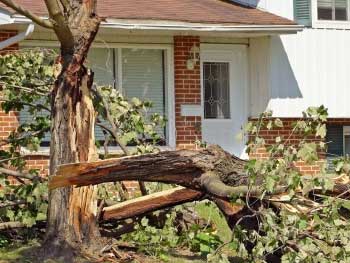
Trees are both useful and beautiful. They serve as wind breaks, give us welcome shade on a hot day, provide oxygen by consuming carbon dioxide, and improve the value of our property. We celebrate Arbor Day, which encourages Americans to plant and care for trees, on April 29 in 2016.
Trees do need care and regular maintenance. If you have trees on your property, you’ll want to look after them, because a large tree that is dying or has dead limbs, or that is loosely rooted in the ground, can cause equally large problems. Trees can fall over in storms, such as in March of 2016 in Howard County, damaging property and even killing those unlucky enough to be in their path. Branches can be torn off or even drop off suddenly if that part of the tree is dead.
Trees or branches can fall with little to no warning. During 2015, several stories of tree injuries were in the news. In April, a Howard County man was flown to Shock Trauma after a tree branch collapsed onto his head in April. During July, eight children were injured when a large tree fell near a children’s museum in southern California; two suffered critical injuries. Also in July of 2015, two boys, ages 8 and 9, were hurt when a large tree branch dropped on them while they were playing in Bronx River Park, New York.
Legal Responsibilities in Maryland Regarding Falling Trees
Liability with regard to falling trees in Maryland depends on a number of factors:
- The location of the property
- Whether you knew the tree was dead, dying, or damaged
- Whether you could have been reasonably expected to know that the tree was dead, dying, or damaged
- Whether you took reasonable precautions to keep an accident from occurring.
Generally, if a tree that is not on your property is overhanging your land, you are allowed to cut back the tree as far as the property line, but you are not allowed to enter your neighbor’s property without consent, nor can you remove the tree.
Preventing Injury Situations with Your Property’s Trees
Trees sometimes give indications of the potential for problems. If you have trees on your property, inspect them yearly and after severe storms. Keep an eye out for the following problems:
- Numerous dead twigs and branches
- Cracks
- Weak branch unions
- Cankers, especially in certain species such as ash
- Decay
- Poor tree form, such as a twisted or unbalanced shape
- Root problems.
Act immediately to have the tree safely taken down if it is dead. If a number of large branches are dead, have them removed by a professional if you cannot do the job yourself. Generally, any branch larger in diameter than four inches has the potential to cause serious injury.
How Can “The Injury Lawyer” Help You?
Steven Heisler has been practicing law in Maryland since 1988. In 1996, however, he decided to focus exclusively on personal injury law. Why? Steve has a heart for helping people. He determined that his education and experience could best be put to use advocating for the rights of folks who were harmed through the negligent actions of others.
If you or a family member has suffered a personal injury due to a falling tree or tree limb because the property owner ignored the safety recommendations detailed above, Baltimore personal injury attorney Steve Heisler stands ready to help you. Keep in mind, however, that there is a statute of limitations – or a time limit – for filing personal injury claims. If you have incurred a personal injury, you should not delay. Contact the Law Offices of Steven H. Heisler of Baltimore, Maryland, today for a free initial consultation by calling (410) 625-4878 or by using our online contact form.
